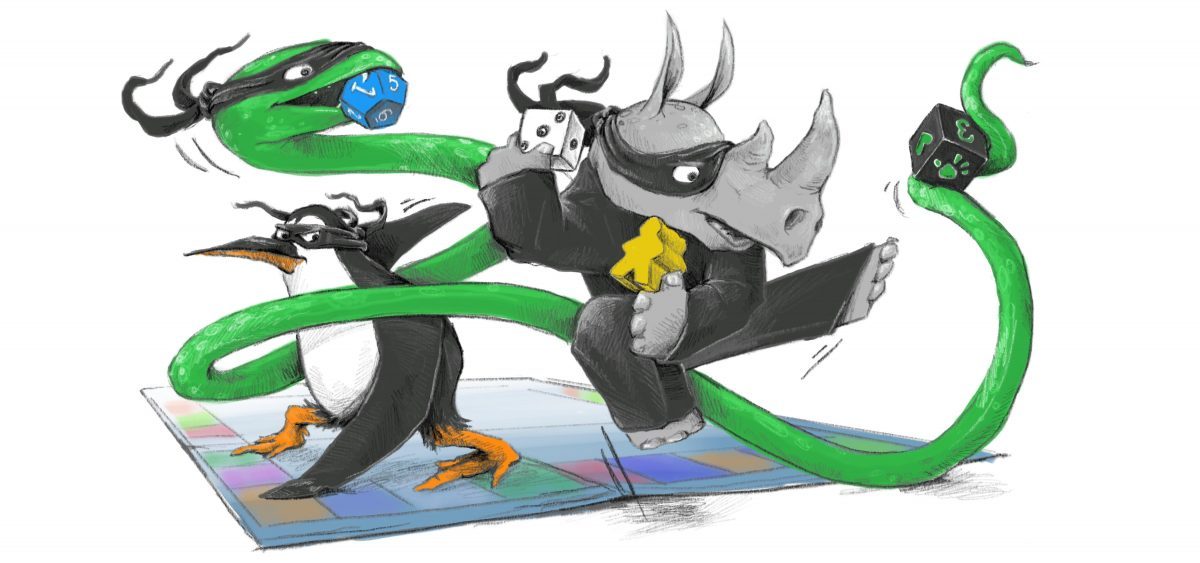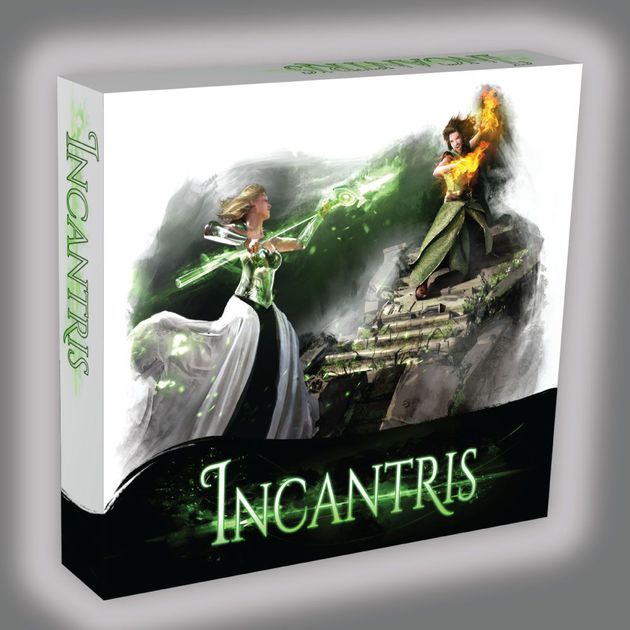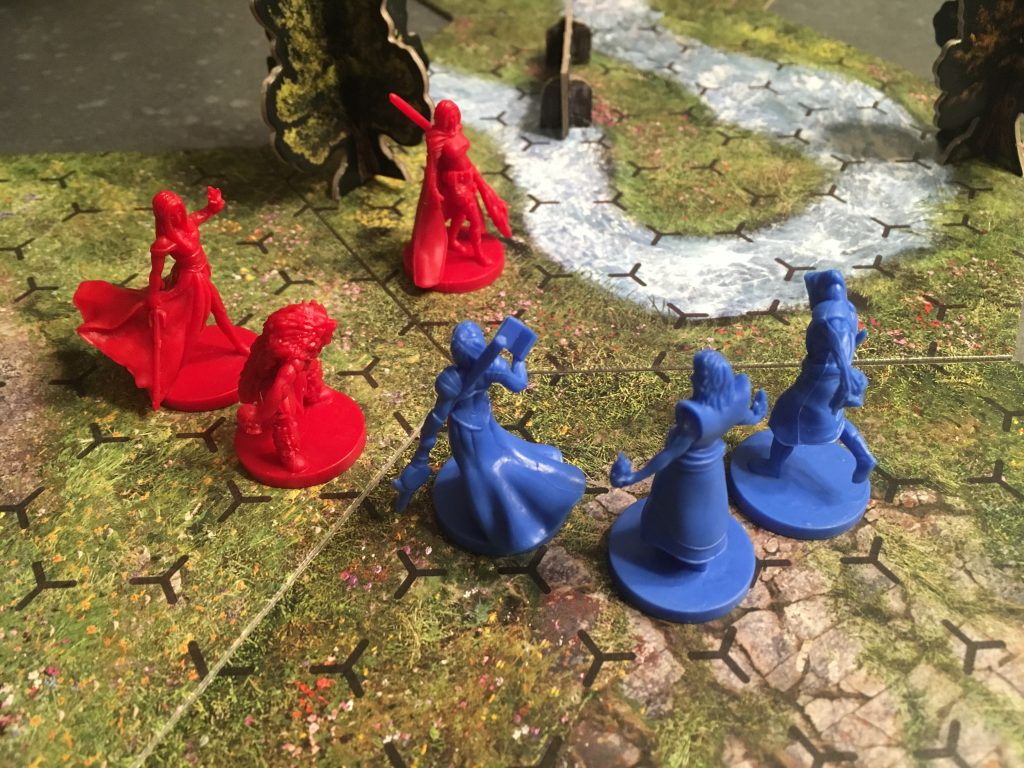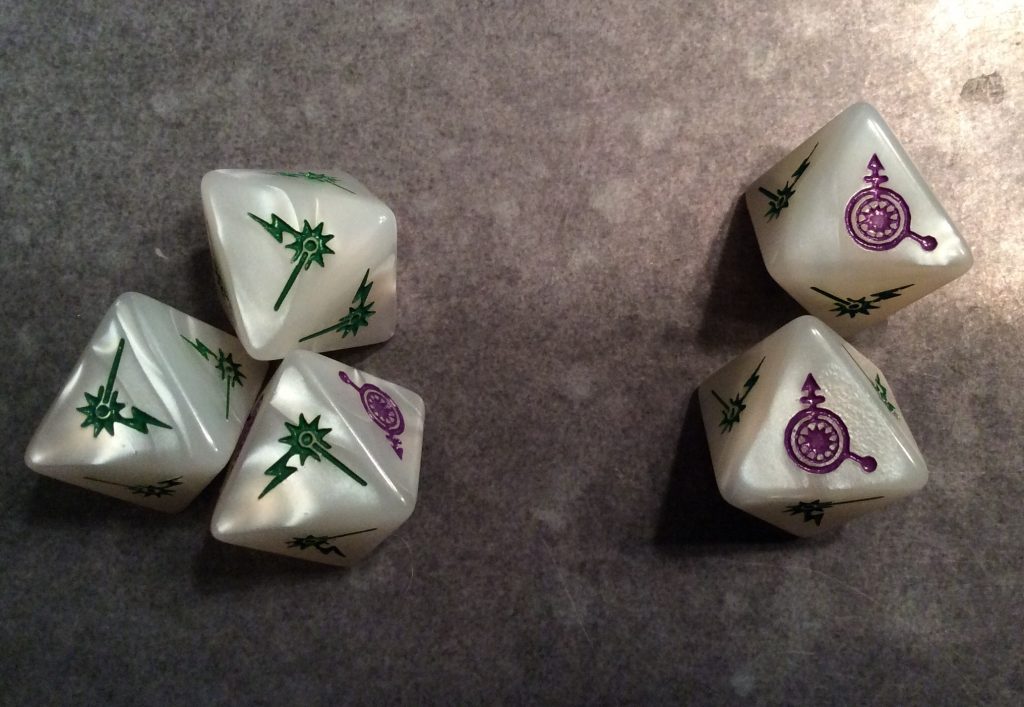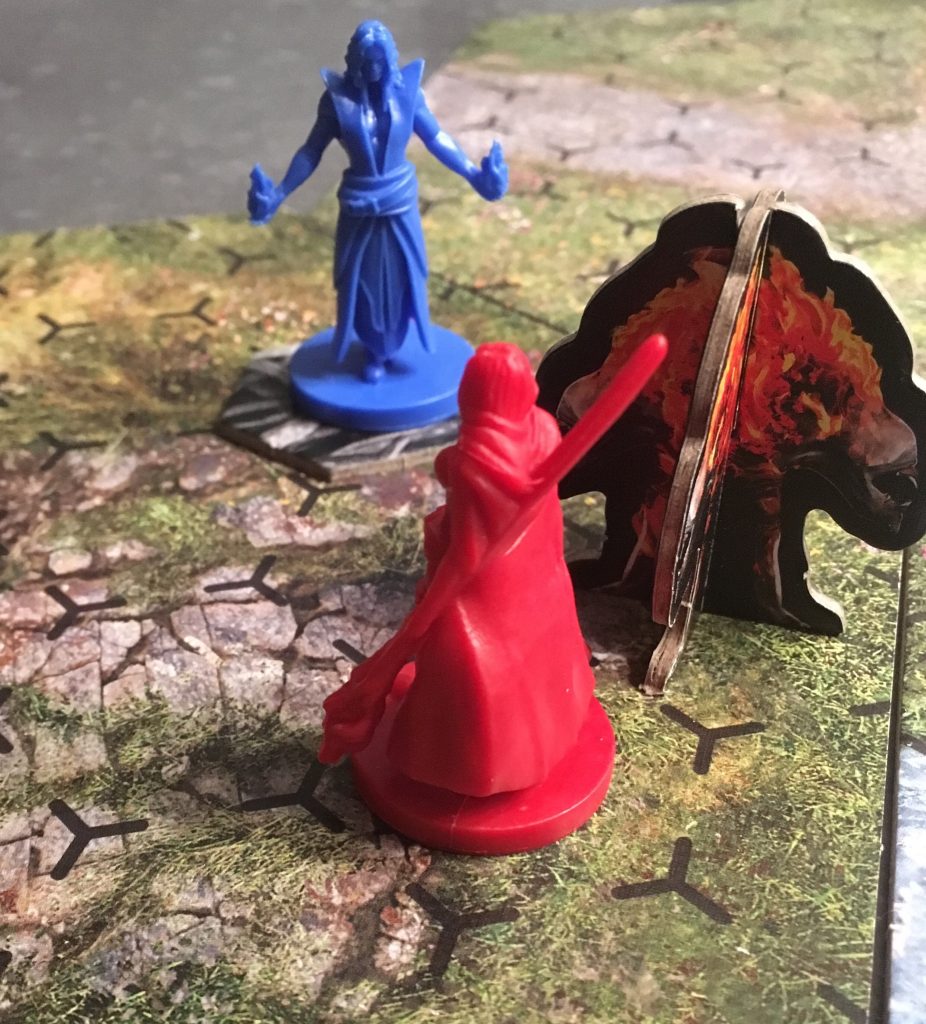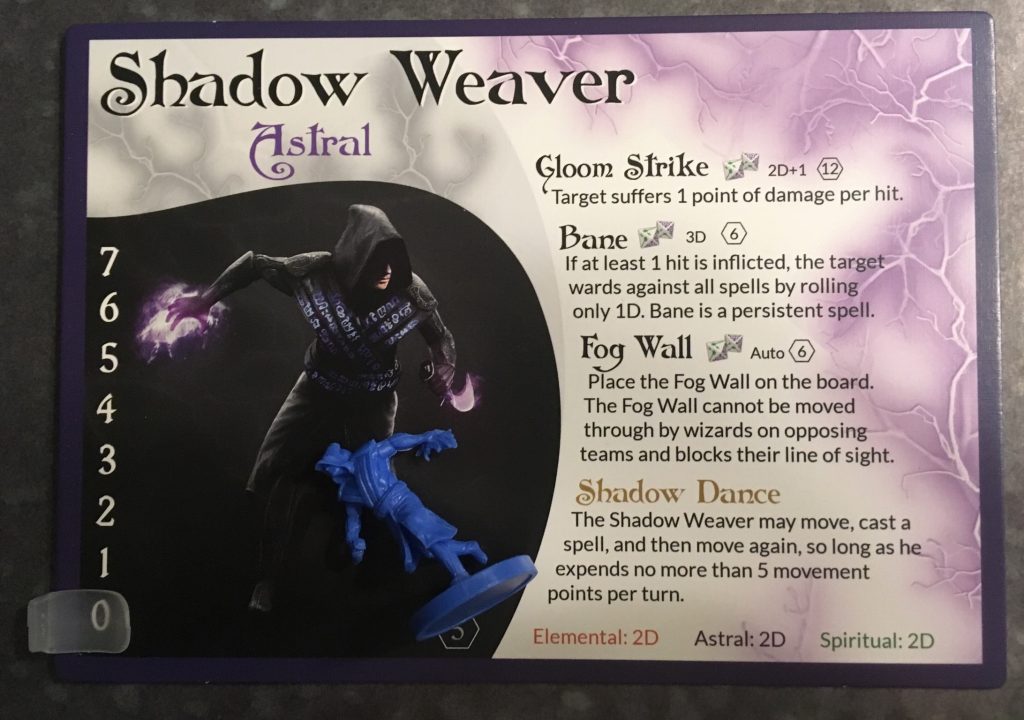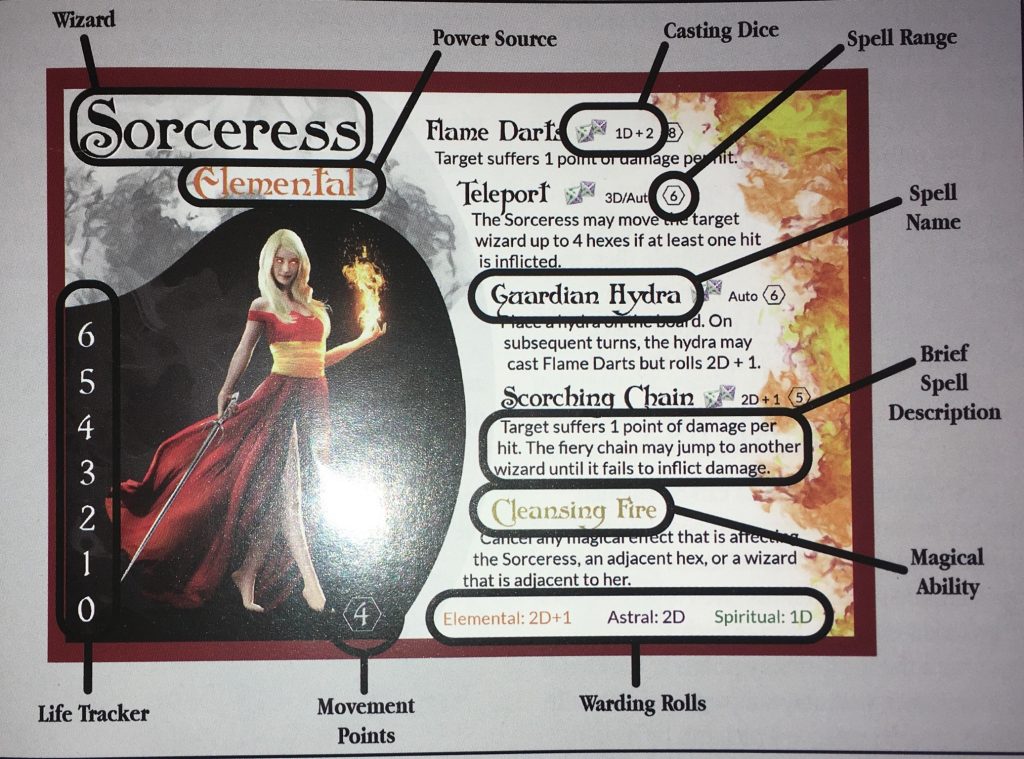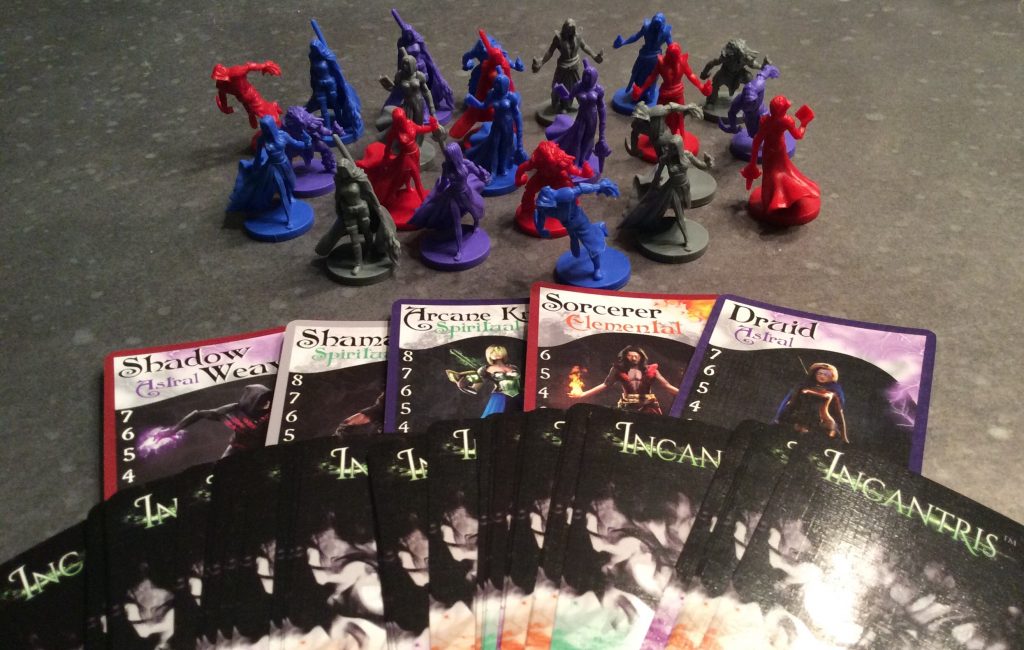So you happen to find yourself surrounded by rival wizards. There’s nothing to do but duke it out with magic and hope to be the last one standing, right?
This is the basic idea of Incantris. You will command a team of 3 magic beings (all referred to as Wizards) vying for control of the Kingdom of Aldramere. Each of the different teams is made up of several character classes each with different powers and abilities: Druids, Shadow Weavers, Sorceresses, Shamen, and Arcane Knights.
Your task is to guide your wizards to victory and prove yourself worthy of being Aldramere’s champions.
Gameplay
Each round consists of up to 3 turns, depending on how many Wizards are still on the battlefield. Every turn you will choose one of your Wizard to activate, then play passes around the table with each player choosing one of their Wizard to activate. This continues until everyone has activated all of their Wizard. Later in the game, as characters are eliminated, not everyone will get an even number of turns. The last player with any Wizards on the board wins.
When you activate a Wizard you may cast a spell and move (in either order). So move then cast or cast then move, whichever puts you in better position or keeps you out of harms way, because your opponents are coming for you next. Choose the spell you want to use and then roll the dice. When casting a spell you are looking to roll Green wands. Your character cards will tell you how many dice to roll and how to modify them. If your Arcane Knight casts Spectral Rush, (2d + 3), you roll 2 dice, count up the number of Green wands and add 3 to it for your attack value.
It’s not all about attacking though, your opponent will get to defend as well. To do this you look at what type of spell is being cast (in the case of the Arcane Knight it’s Spiritual) and find that the defense numbers across the bottom of the defending Wizard corresponding to that type of Attack. You then roll the dice in the same way as Attacking adding all modifiers. When defending, you are looking to roll Purple Wards. Any attacks not warded count as damage and the defending player loses hit points.
Example: Player 1 Attacks with their Arcane Knight, casting Spectral Rush (2D+2) on their opponent’s Shadow Weaver. They roll 2 dice and get 2 Green Wands for a total attack of 4. Player 2 Defends with their Shadow Weaver who rolls 2D to ward off the Arcane Knight’s Spirtual attack. They roll 1 Purple Ward and 1 Green Wand and so only ward off 1 point of damage. The Shadow Weaver takes 3 points of damage and drops their health from 7 to 4. Now it’s Player 2’s turn to activate a Wizard…
It’s a pretty simple battle system, so of course the majority of the fun comes from trying to strategically place your Wizards in positions where they will be in range to do the most damage while defending themselves .
So what do we think?
Incantris is basically a beginners guide to tabletop skirmishes. It is no where near heavy enough to even be an intro to war gaming, and for that I am thankful. This is just about the right amount of battling for me. You see every time I try to play tabletop warfare games, I end up rolling so bad that I spend the entire game dropping my weapons or reloading, or in some way fumbling around. The rules are usually convoluted or the game takes way to long, or there is a huge army to be purchased and setup before ever playing the game. Not to mention the figure envy that comes when people bring out there huge boxes of superbly painted miniatures. Maybe it’s just me.
Incantris fixes all of that for me. It’s light enough for gamers like me who don’t often enjoy this type of game, and is actually easy enough to teach as a gateway game. I will admit that when I first got the game it seemed a little intimidating upon opening the box, mostly because the rulebook is 23 pages long and that is a lot for me. But, turns out it is really well written, and the creators have produced a couple of videos that they used for their Kickstarter campaign that explain the whole game in about 10 minutes. Very slick.
I like that I the game provides choices, but that they are not overwhelming, causing me to dwell on what to do on my turn for way too long. The minis are great and really look good in play. The other components are very decent, although it did take me a few minutes to determine what some of them were supposed to be.
The mechanics are wonderfully simple and very easy to grasp right from the beginning, making it incredibly easy to teach. In fact once you have played once, you can teach it to someone else in about 5 minutes. The character boards have everything you need laid out for you and readily available. I stole this image from the rule book because it illustrates how great they are:
I am usually not a fan of player elimination, but these games are so quick that you won’t be out of the game for very long before the whole thing is over and you can start again. There is lots of replayability in this box since you will have to play it at least 4 times before playing through all of the base character combinations. In addition, there are a number of scenarios (4 included with the base game) that allow you to manipulate the arena, play a version of Capture the Flag or even string a number of scenarios together to form a campaign.
Even better than that, there is a Wizard Design Kit that allows you to customize and put together your own team of Wizards to have a dream team of Wizards to fight with and then use Spell cards to draft spells to fight with. Plus the design kit comes with over 20 more minis.
This is a game that has a lot of staying power as a gateway game and a short light game for the beginning or end of a game night . “We’ve got 30 minutes left – how bout a game of Incantris?”
If you’re looking for a 3 hour complicated war game encompassing vast tabletop terrain, this one is not for you. If you are ok with a quick, light, fun version of that, you need to try Incantris.
Ninja Approved.
Incantris was sent to us by Rainn Studios I n exchange for an honest review, which is exactly what we provided.
